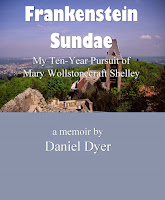The Last Man and Jack London ...
The writer
whose works and life I pursued with some passion (madness?) before Mary Shelley was Jack London. In
the 1980s and 1990s I read all of his books, visited many of the sites that
were significant in his life (two trips to Alaska and the Yukon), read all the
other biographies of him, published an illustrated and annotated edition of The Call of Wild (1995) and in 1997
published a YA biography (Jack London: A
Biography).
As you may
remember, 1997 was the year that my Mary Shelley obsession ignited, so Jack
drifted off on his ship (he’d owned several vessels, including the ill-fated Snark, about which both he and his
second wife, Charmian Kittredge London, wrote volumes), and I turned
exclusively Mary-ward.
The
relevance here? When I read that in 1826 Mary Shelley had written a novel about
a plague that wipes out most of humanity, I was acutely aware that Jack London
had done much the same in his (much briefer) novel The Scarlet Plague, 1915, a novel that followed after what many
consider his most significant works, The
Call of the Wild (1903), The Sea-Wolf
(1904), White Fang (1906), and Martin Eden (1909). He wrote many other
fine works—but these are probably the ones that remain most prominently in the
public awareness.
I read The Scarlet Plague, I see in my notes, in
November 1986. I was on a sabbatical leave that year from the Aurora (Ohio)
City Schools—and my sabbatical proposal had been … to read the works of Jack
London and to travel to relevant sites in his life. Our new eighth-grade
literature anthology included The Call of
the Wild, and I felt I didn’t know enough (to say the least!) about London,
the Klondike Gold Rush (the historical context of the novel), and numerous
other things, so I applied for and received that sabbatical.
I have a
single page of handwritten notes—a plot summary of the novel—and later I seem
to have expanded them—a page and a bit more on a dot-matrix printer (the print
is fading as I type this!). I have a first edition of the novel—but where? I
just went through my London collection and came up Plague-less, so this may be another developing story!
So how did
London handle the same sort of story that Mary had written nearly a century
earlier?



No comments:
Post a Comment